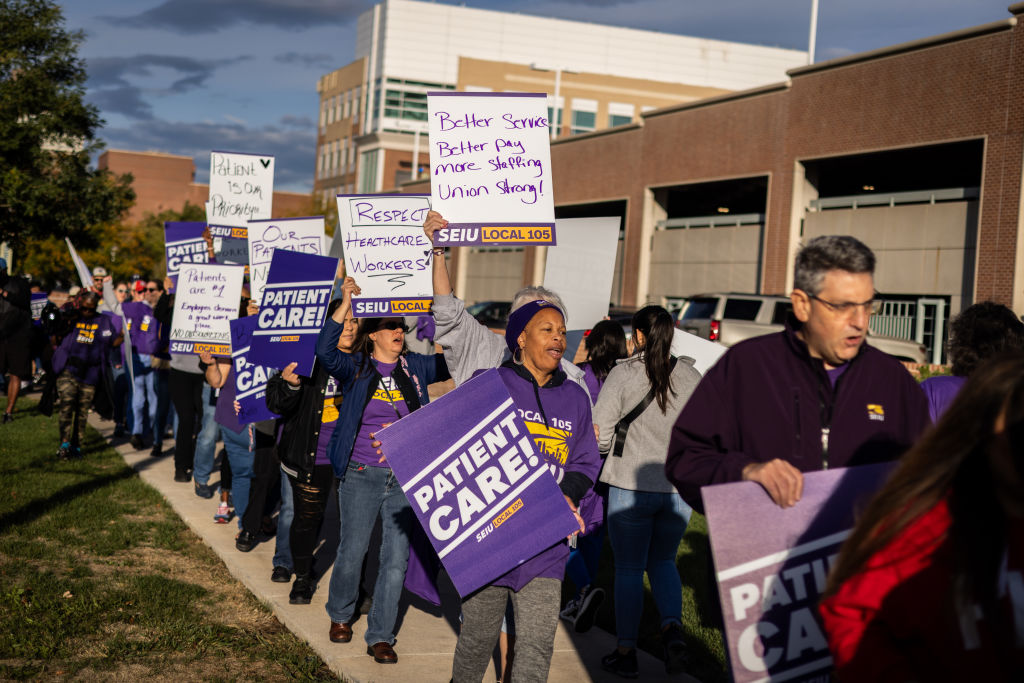Nurse Strike Update: Kaiser Permanente Strike Underway and It’s the Largest Healthcare Strike in History
 Credit: Bloomberg via Getty Images
Credit: Bloomberg via Getty Images- More than 75,000 healthcare workers led by the Coalition of Kaiser Permanente Unions took to the picket lines Wednesday morning after their contract expired.
- The Coalition wants to eliminate healthcare vacancies, increase staffing-to-patient ratios, and increase across-the-board raises.
More than 75,000 healthcare workers led by the Coalition of Kaiser Permanente Unions took to the picket lines Wednesday morning after their contract expired. The strike is labeled as an unfair labor practice strike because of the illegal bargaining practices committed by Kaiser Permanente.
The Coalition represents 11 unions across the U.S., including California, Oregon, Washington, Colorado, Virginia, and Washington, D.C. It also represents about 85,000 frontline healthcare workers. The healthcare workers include registered nurses, licensed practical nurses/licensed vocational nurses, certified nursing assistants, clinical assistants, surgical assistants, pharmacists, and sonographers.
Kaiser Permanente workers announced the decision to hold strike votes at a press conference in mid-August. The strike, drawing national attention, is the largest healthcare worker strike in U.S. history.
Why Is the Kaiser Permanente Nurse Strike Happening?
Kaiser Permanente healthcare workers are striking for several reasons. In its new agreement, the Coalition of Kaiser Permanente Unions is bargaining for:
- Across-the-board raises: Kaiser has only offered 2-4% annual raises, which the Coalition states “fails to keep up with the cost of living for anyone,” as stated on their website. They are proposing a 5.7%-6.5% raise across the board.
- Protections against subcontracting and outsourcing: As stated in the original agreement with Kaiser, the Coalition wants to keep the revenue cycle workforce. However, Kaiser wants to outsource the revenue cycle.
- Applying the partnership to acquisitions: Kaiser wants to expand non-union and low-wage/low benefits to companies they acquire. The Coalition wants Kaiser to continue offering unionized facilities when obtaining new businesses and facilities.
- Premium subsidy/HRA retiree medical: The Coalition is seeking improvements to the premium subsidy/HRA retiree medical plan.
- PSP bonus: The Coalition wants Kaiser to come up from their $750 max offer from the PSP bonus, a bonus paid out to frontline workers based on performance.
Lastly, the Coalition wants to eliminate vacancies and increase staffing-to-patient ratios. Short staffing leads to burnout, which causes many healthcare workers to leave the profession.
At the press conference, Dave Reagan, president of SEIU United Healthcare Workers West, the Coalition’s largest union, pointed out that Kaiser Permanente is a not-for-profit healthcare company. However, the company took in over $25 billion in revenue this year.

Unfortunately, their experience with Kaiser has been different than what they hoped, Reagan stated. Representatives at Kaiser refused to enter the room and bargain with union leaders, which is against the law.
“We have filed over a dozen bad faith bargaining charges both for the individual local unions and the Coalition as a whole. We expect to prevail on those with the National Labor Relations Board represented by the coalition unions,” Reagan stated.
Getting an appointment and non-urgent appointments will be interrupted due to the strike, but Kaiser has plans in place to care for patients during the strike by bringing in temporary workers.
Before the strike, Kaiser said in a statement, “While these plans to strike are disappointing, we remain committed to reaching an agreement that is good for our employees, members, and organization, and we will continue to bargain in good faith with the Coalition.”
The Kaiser Permanente Strike: What Happens Now?
Unless an agreement is met, the strike will last through 6 a.m., Oct. 7. Meanwhile, healthcare workers will continue to walk off the job. Workers will stand in solidarity for better staffing and working conditions, which in turn will improve patient care. The SEIU-United Healthcare Workers West posted images of the picket lines on its Instagram, with members holding signs stating “Kaiser workers won’t be silenced.”
In September, Kaiser Permanente sent a video to employees represented by the Coalition of Kaiser Permanente Unions. The message highlighted how it values its employees, and while it respects workers’ right to strike, workers should think about how the strike will impact families and patients.

Nurse Strikes: Part of a National Trends
Strikes have become a national trend affecting the automotive industry, aviation, actors, and writers. Nurses have also made national headlines in recent strikes, including:
- A 24-hour walkout at SSM Health St. Louis University Hospital
- Robert Wood Johnson University Hospital in New Brunswick, New Jersey
- Nurses in Oregon led by Oregon Nurses Association
Nurses in Oregon were victorious in reaching an agreement that provided pay increases between 17-27% and an additional 40 hours of paid time off.
Strikes are costly and affect all stakeholders. They disrupt patient care and cause disruptions in the healthcare system. However, strikes can be very powerful and allow nurses and healthcare workers to advocate for themselves and work with employers to find common ground.
You might be interested in

Nurse Strike Update: The Latest on Nursing Strikes and Labor Disputes Around the Country
Nurse strikes are underway around the country, while others are seeing results at the bargaining table.

What Happens When Nurses Strike? Exploring the Aftermath
Nurses are organizing and striking more than ever before in the U.S. Learn how nursing strikes work and the benefits nurses and patients gain from them.